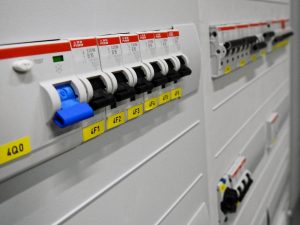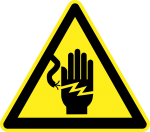There are vast differences between the specialized roles within the industry.
These differences are apparent from the very start, influencing the type of apprenticeships electricians take and the licenses they obtain.
Such is the case for two major electrician classifications:
- Inside wireman works primarily on residential and commercial wiring projects inside the premises
- Outside lineman work mainly on power transmission lines outside the premises
Later on, you will decide what specialty you’ll take that will define your entire career.
That’s why, on this page, you’ll learn what a wireman and a lineman are and the work involved in each.
What’s Involved in Working as an Inside Wireman
The inside wireman handles a wide scope of tasks.
They can deal with a specialized aspect of non-premises distribution and wiring.
They can work in a variety of settings, from dealing with a simple wiring schema in a residential home to high-voltage machinery at a major factory.
Regardless, inside wiremen handle lower voltages than linemen.
They also have a definite work advantage in that their work is more predictable in terms of tasks and schedules.
However, those engaged in construction or repair may still have to deal with emergencies occasionally.
A Wireman Performs Specialized Work in a Variety of Settings
Electricians can perform tasks in various conditions depending on their specialization.
Some of them, such as marine or aircraft electricians, may work inside almost all the time, sometimes in restricted spaces.
Such professionals as solar or wind power electricians may have to work outside mostly, working on rooftops.
Some of them don’t work on systems with more than 5 volts, such as alarm wiring systems.
Others may have to carefully handle industrial plant electrical wiring with about 230kV.
Wiremen use a variety of tools and techniques, including simple multimeters or sophisticated tone generators (usually referred to as toners), which can help take out individual wires from a bulk.
They work with multiple specialized types of equipment as well to handle intricate wiring setups.
However, they don’t work with high voltage types that require protective gear that linemen use.
While working, wiremen can shut down the circuits they handle, so the wiring isn’t energized.
What’s Involved in Working as an Outside Lineman
When you drive down the road, you may spot a few orange cones, a bucket truck pulled off by a utility pole, and some flashing lights.
It means that high up in the air, a lineman electrician is working to keep the electricity of the modern world going.
A lineman handles the maintenance of the transmission cables network transmitting electricity from generating facilities to the users.
Users can include homes, schools, offices, hospitals, industrial facilities, etc.
They also deal with fixing, stringing, and maintaining a variety of transmission cables, such as fiber-optic lines, telecommunications, or cable television.
High-voltage linemen handle high-tension lines located hundreds of feet in the air that transmit electricity from the source at the power plant to sub-stations that distribute electricity to homes and businesses at safe levels.
Dealing with Heights, Underground Wiring Vaults, and Exposure to the Elements
Linemen electricians perform their tasks outside.
They deal with massive wiring vaults underground or laying wire in ditches through culverts.
Bucket trucks also aren’t the only way they reach the high sites to get the line jobs done.
Some linemen may free-climb up wooden utility poles, strapped on a pair of spikes, to get to the wires.
Electricians servicing high-tension high-voltage power lines that cover huge distances travel by helicopters.
They can take them over massive transmission towers 500 feet up above the ground.
Linemen would climb out into the air directly to the wires carrying 115 or more kilovolts of raw power.
The work of a lineman can be highly physical and often involves being out in harsh weather.
This typically happens when the lines go down.
They also have to carry heavy equipment and work high above the ground while repairing the lines.
Typically, linemen work for a specific power utility district or telecommunications company.
So, they often handle the installation, servicing, or repair of the infrastructure owned by a company.
Linemen employed with large contractors usually work on different types of infrastructure, including high-voltage power transmission lines, cell towers, etc.
Unique Safety Considerations and Tools of the Trade for Linemen
Linemen undergo extensive safety training, including climbing school and performing high-angle rescues.
This can be necessary if another lineman gets injured up on a tower.
Linemen use specialized tools to work with high-voltage running in transmission lines.
They have to wear personal protective equipment (PPE) that protects them against shocks.
Also, they use long insulated poles, a.k.a. hot sticks, to complete various tasks that require them to touch the lines physically.
They work with high-tension lines transmitting voltages over 115kV.
So, they may have to wear Faraday cage suits that direct the electricity around the outside surface instead of grounding their bodies.
This way, they can work safely on high-voltage lines without the need to disrupt the power running from the power plant to local sub-stations.
They have odd working hours where they may have to be always on-call to handle the damage to lines wherever and whenever it happens.
For instance, repairing damages to transmission lines caused by major storms.
Apprenticeship and Certification Requirements for Inside Wireman and Outside Lineman
To become a wireman or a lineman, one usually starts with an apprenticeship program.
They work as apprentices with a relatively low payment, and, over time, advance to the level of a journeyman.
Eventually, they can become a master electrician.
Both professionals have to spend up to ten years on the job to become master electricians.
Comprehensive information on regional apprenticeship programs for both linemen and wiremen can be found through the National Joint Apprenticeship and Training Committee (NJATC).
With heavy unionization in the industry, linemen and wiremen need a union ticket from the International Brotherhood of Electrical Workers (IBEW).
Licensing requirements for both specializations are set by states or jurisdictions, involving different examinations, and classroom and hands-on training hours requirements.
Licenses can also depend on the level of voltage, with various standards and requirements for workers handling wiring under 30 volts or over 115 kV.
Becoming a Wireman
Inside wiremen usually start at a technical school.
They can earn an associate’s degree in electrical engineering at a two-year community college, which is a solid step in the industry.
For some jobs, they may require special certifications.
For instance, marine electricians usually need the American Boating and Yachting Council (ABYC) certification to get hired in the field.
Apprentices can usually work in the area directly related to their specialization, e.g., commercial, residential, industrial, or low-voltage.
However, they work under the strict and direct supervision of senior partners until they become a journeyman.
Becoming a Lineman
Lineman apprenticeship programs usually take up to four years to complete.
Apprenticeships are available directly through electrical contractors or utility companies.
However, unions and cooperative non-profit organizations hold most of the apprenticeships.
To become a lineman, you need a 10-hour Transmission and Distribution certification from Occupational Safety and Health Administration (OSHA).
Other local or regional certifications may be required as well.
Most linemen need to have a Class A Commercial Driver’s License.
However, apprenticeship programs can help candidates work towards acquiring this credential as well.
Apprentice linemen usually spend most of their time on the ground assisting the journeyman working with cables or overhead.
They serve as gofers.
Eventually, they will do some high-wire work as they learn.
Salaries and Job Prospects for Electrical Wireman and Lineman
In both occupations, apprentices can expect to make 30-50% of the journeyman’s wages.
Wireman
Electrical wiremen had a median salary of $51,880 in 2015, according to the Bureau of Labor Statistics (BLS).
Employment is projected to grow by 14% over the next decade.
The salary of entry-level electricians is around $40,000, however, it can vary depending on the specializations, type of apprenticeship, and region.
A variety of companies hire them, from residential construction contractors to industrial manufacturing.
The job outlook can vary drastically by region.
Generally, the job growth for electricians is stronger in regions with extensive construction and industrial development.
Lineman
According to BLS, the employment of linemen electricians should grow by 6% over the next 10 years.
However, with relatively high pay, job security, and low educational requirements, the field can be quite competitive.
Due to the demanding work and odd hours, outside linemen usually receive higher compensation than wiremen.
As per the report of the BLS, the median salary for a lineman was $61,430 in 2015.
However, the rates can vary by region and licensing level.
For instance, as shown by the job ads published in July 2016, a Tennessee Valley Authority (TVA) journeyman made a starting salary of $63,950.
On the other hand, a journeyman employed in California made $99,570.
Despite the location, with more experience, you can increase your salary by 50% or more, up to six figures.
This page is also available in Spanish.










